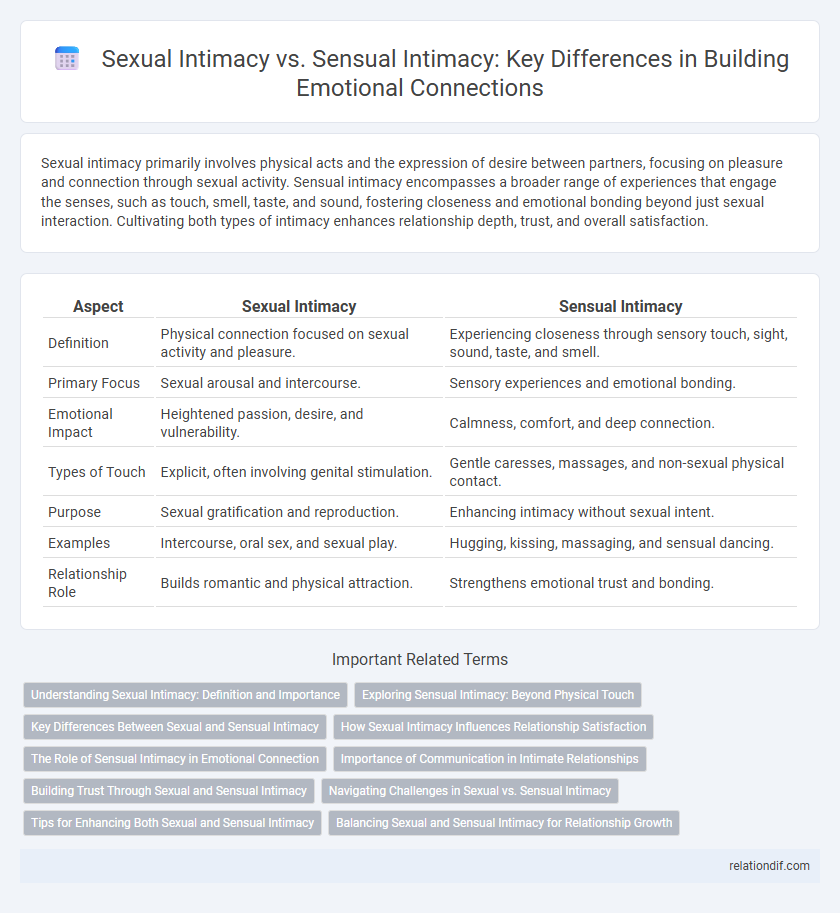Sexual intimacy primarily involves physical acts and the expression of desire between partners, focusing on pleasure and connection through sexual activity. Sensual intimacy encompasses a broader range of experiences that engage the senses, such as touch, smell, taste, and sound, fostering closeness and emotional bonding beyond just sexual interaction. Cultivating both types of intimacy enhances relationship depth, trust, and overall satisfaction.
Table of Comparison
| Aspect | Sexual Intimacy | Sensual Intimacy |
|---|---|---|
| Definition | Physical connection focused on sexual activity and pleasure. | Experiencing closeness through sensory touch, sight, sound, taste, and smell. |
| Primary Focus | Sexual arousal and intercourse. | Sensory experiences and emotional bonding. |
| Emotional Impact | Heightened passion, desire, and vulnerability. | Calmness, comfort, and deep connection. |
| Types of Touch | Explicit, often involving genital stimulation. | Gentle caresses, massages, and non-sexual physical contact. |
| Purpose | Sexual gratification and reproduction. | Enhancing intimacy without sexual intent. |
| Examples | Intercourse, oral sex, and sexual play. | Hugging, kissing, massaging, and sensual dancing. |
| Relationship Role | Builds romantic and physical attraction. | Strengthens emotional trust and bonding. |
Understanding Sexual Intimacy: Definition and Importance
Sexual intimacy refers to physical acts that involve sexual activity between partners, emphasizing biological and emotional connection through touch, arousal, and shared pleasure. Understanding sexual intimacy is crucial for maintaining healthy relationships, as it fosters trust, vulnerability, and mutual satisfaction. Unlike purely sensual intimacy, which centers on non-sexual physical closeness and sensory experiences, sexual intimacy integrates emotional bonding with physical expression.
Exploring Sensual Intimacy: Beyond Physical Touch
Exploring sensual intimacy extends beyond physical touch by fostering emotional connection, trust, and mutual understanding, which deepens relational bonds. Sensual intimacy engages all the senses--sight, sound, taste, smell, and touch--creating a rich, immersive experience that enhances closeness between partners. Unlike sexual intimacy, which centers on physical acts, sensual intimacy cultivates presence and attentiveness, nurturing a profound emotional and psychological connection.
Key Differences Between Sexual and Sensual Intimacy
Sexual intimacy primarily involves physical acts focused on sexual gratification and reproduction, whereas sensual intimacy emphasizes non-sexual touch and sensory experiences that foster emotional closeness and comfort. Sexual intimacy often includes activities like intercourse and explicit physical contact, while sensual intimacy involves elements such as cuddling, massage, and affectionate gestures that engage the senses. These distinctions highlight how sexual intimacy centers on physical release and desire, whereas sensual intimacy nurtures connection through tactile and emotional bonding.
How Sexual Intimacy Influences Relationship Satisfaction
Sexual intimacy strongly correlates with relationship satisfaction, enhancing emotional closeness and trust between partners. Regular sexual activity releases oxytocin, a hormone that fosters bonding and reduces stress, thereby deepening connection and overall happiness in the relationship. While sensual intimacy emphasizes non-sexual physical touch and emotional presence, sexual intimacy uniquely combines physical pleasure with vulnerability, which directly impacts relationship quality and partner satisfaction.
The Role of Sensual Intimacy in Emotional Connection
Sensual intimacy enhances emotional connection by engaging multiple senses, fostering deeper understanding and trust between partners. Unlike sexual intimacy, which centers primarily on physical gratification, sensual intimacy emphasizes touch, scents, sights, and sounds that build a rich emotional landscape. This multi-sensory approach cultivates vulnerability and closeness, strengthening the relational bond beyond physical acts.
Importance of Communication in Intimate Relationships
Effective communication forms the foundation of both sexual and sensual intimacy, enabling partners to express boundaries, desires, and emotional needs clearly. Open dialogue fosters trust and reduces misunderstandings, enhancing connection and satisfaction within intimate relationships. Prioritizing honest conversations helps sustain long-term intimacy by aligning expectations and nurturing mutual respect.
Building Trust Through Sexual and Sensual Intimacy
Building trust through sexual intimacy involves open communication, mutual consent, and respecting boundaries, which deepens emotional connection. Sensual intimacy, characterized by non-sexual touch and shared sensory experiences, fosters comfort and vulnerability, strengthening trust. Both forms of intimacy create a safe space where partners feel valued and understood, essential for a resilient relationship.
Navigating Challenges in Sexual vs. Sensual Intimacy
Navigating challenges in sexual intimacy often involves addressing physical communication, consent, and emotional vulnerability, while sensual intimacy emphasizes tactile sensations, closeness, and non-sexual physical connection. Understanding the distinction between sexual intimacy's goal-oriented nature and sensual intimacy's focus on presence and sensory experience helps couples foster deeper emotional bonds. Recognizing individual needs and boundaries in both forms of intimacy promotes healthier relationships and mutual satisfaction.
Tips for Enhancing Both Sexual and Sensual Intimacy
Prioritize open communication to express desires and boundaries clearly, fostering trust and emotional safety in both sexual and sensual intimacy. Incorporate mindful touch and non-sexual physical closeness, such as hugging or cuddling, to deepen connection and increase oxytocin levels that enhance emotional bonds. Explore shared experiences like massage or slow dancing to stimulate sensory awareness and elevate mutual pleasure beyond physical intercourse.
Balancing Sexual and Sensual Intimacy for Relationship Growth
Balancing sexual intimacy and sensual intimacy is crucial for fostering deep emotional connections and sustaining long-term relationship growth. Sexual intimacy involves physical acts of desire and pleasure, while sensual intimacy emphasizes non-sexual touch and emotional closeness through senses like touch, taste, and smell. Prioritizing both aspects enhances trust, communication, and overall relationship satisfaction, ensuring partners feel connected on multiple levels.
sexual intimacy vs sensual intimacy Infographic

 relationdif.com
relationdif.com